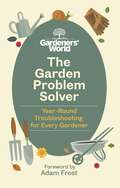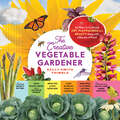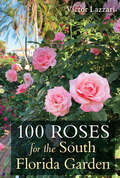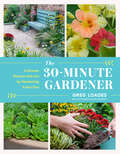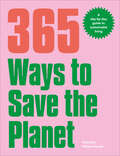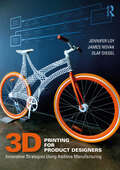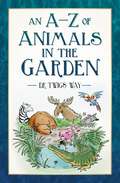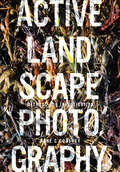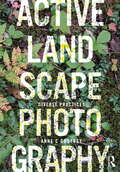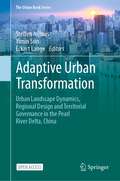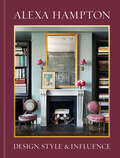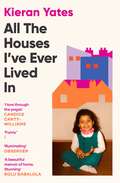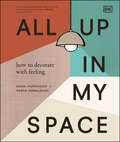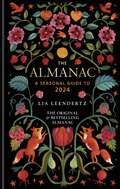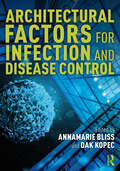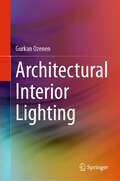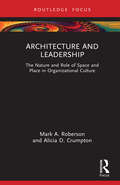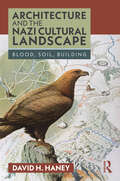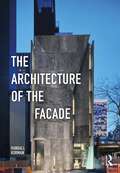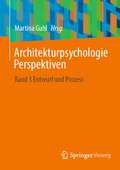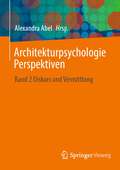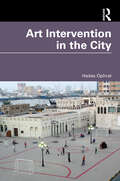- Table View
- List View
The Gardeners’ World Problem Solver: Year-Round Troubleshooting for Every Gardener
by BBC Gardeners’ World Magazine Adam FrostEven with the best planning and care, every garden can run into a problem or two. Whether you are beset with beetles or blighted by blackspot, The Garden Problem Solver has the solution.Guided by the team of experts at Gardeners' World - including advice from Monty Don, Alan Titchmarsh, Carol Klein, Arit Anderson, Adam Frost and more - The Garden Problem Solver contains the practical tips, tricks and techniques to deal with the obstacles that every home gardener has to face.Broken down into easy-to-follow steps, this handy guide will help you anticipate, avoid and troubleshoot the most common garden problems which crop up when growing your favourite fruit, veg, flowers and more.With a foreword by Adam Frost and complemented with hand-drawn illustrations, The Garden Problem Solver holds the secrets to making your garden look its very best.
The Creative Vegetable Gardener: 60 Ways to Cultivate Joy, Playfulness, and Beauty along with a Bounty of Food
by Kelly Smith TrimbleWith interest in vegetable gardening booming, lifestyle editor and master gardener Kelly Smith Trimble offers designs, ideas, and inspiration for making the vegetable garden a joyful, creative space that reflects each gardener's distinctive aesthetic, integrates beauty with functionality, and offers a sanctuary for both people and pollinators, along with a bounty of nutritious, homegrown food.
100 Roses for the South Florida Garden
by Victor LazzariTried and true varieties for tropical FloridaContrary to common belief, many varieties of roses can flourish in Florida’s heat and humidity. A much-needed guide for both home gardeners and landscape professionals, 100 Roses for the South Florida Garden equips readers with the knowledge to successfully grow this popular plant in the state’s tropical climate. Rose connoisseur Victor Lazzari surveys the history of the rose; outlines the main classifications of roses; explains how to best cultivate the flower in the South Florida environment; and offers advice on designing thoughtful, eco-friendly, visually spectacular gardens with roses in this region. Lazzari then provides an illustrated compendium of 100 varieties of roses that work well in South Florida. Each entry contains a beautiful full-color photograph, a brief history of the rose variety, and notes on the variety’s preferences. Complete with a thorough list of local rose retailers and organizations, this book is filled with useful information that has previously been difficult for Florida residents to locate. New gardeners and dedicated rosarians alike will delight in this approachable, eye-catching resource for finding and growing roses that thrive in the southernmost part of the state.
The 30-Minute Gardener: Cultivate Beauty and Joy by Gardening Every Day
by Greg LoadesFind happiness, connection, and accomplishment by cultivating your garden life every day of the week using this inspiration-packed guide that shows aspiring gardeners exactly what they need to know. Are you ready to discover your garden&’s unexpected gifts? All it takes is a daily practice. In The 30-Minute Gardener, Greg Loadesreveals what dedicated time spent in the garden every day can create: a moment of solitude in a busy world, a welcoming space to enjoy with family and friends, and an increased connection to nature. In this practical and inspiring guide you&’ll find advice on tasks such as pruning a rose bush and planting bulbs, inspired ideas for transforming an overgrown garden into a beautiful flower-filled haven, and hints on how best to savor your garden and enjoy your accomplishments.
365 Ways to Save the Planet: A Day-by-day Guide to Sustainable Living
by Georgina Wilson-PowellStep up your sustainability and unlock your full eco potential with 365 easy, trackable changes. What if sustainability didn&’t have to be so complicated? 365 Ways to Save the Planet cuts through the noise and explains exactly how to live a &“greener&” lifestyle day by day. With its approachable ideas and achievable daily actions, anyone can up their sustainability score with this book on eco-friendly living. Georgina Wilson-Powell breaks down the significance of environmental statistics for issues big and small, and quantifies the difference low-effort, high-impact changes can make. In her year-long programme, each action is accompanied with a simple &“Impact Index&” to bring the statistics to life, making it easy to track your progress. Reflect positively on the impact you are having on the environment, across work, home, holiday, and more, for the duration of a full year. Dive into the pages of this superb sustainability book to discover: - Daily actions and reflections focus on different, key sustainability issues to build into your routine.- Pages include inspiring mottos, overarching statistics, and illustrations to create a bold, colourful course for the year.- An impact index accompanies each daily action helping you to measure your footprint and reflect on the difference you can make. This green-living guide presents the facts and suggests changes to readers&’ lifestyle for every day. If you want to make a difference but don&’t know where to begin, simply turn the page and start with day one, and learn how to break previous habits and shift your mindset. Being green has never been easier!
3D Printing for Product Designers: Innovative Strategies Using Additive Manufacturing
by Jennifer Loy James Novak Olaf Diegel3D Printing for Product Designers closes the gap between the rhetoric of 3D printing in manufacturing and the reality for product designers. It provides practical strategies to support the adoption and integration of 3D printing into professional practice. 3D printing has evolved over the last decade into a practical proposition for manufacturing, opening up innovative opportunities for product designers. From its foundations in rapid prototyping, additive manufacturing has developed into a range of technologies suitable for end-use products. This book shows you how to evaluate and sensitively understand people, process, and products and demonstrates how solutions for working with additive manufacturing can be developed in context. It includes a practical, step-by-step plan for product designers and CEOs aimed at supporting the successful implementation of 3D printing by stakeholders at all levels of a manufacturing facility, tailored to their stage of technology integration and business readiness. It features a wide range of real-world examples of practice illustrated in full colour, across industries such as healthcare, construction, and film, aligning with the strategic approach outlined in the book. The book can be followed chronologically to guide you to transform your process for a company, to meet the unique needs of a specific client, or to be used as a starting point for the product design entrepreneur. Written by experienced industry professionals and academics, this is a fundamental reference for product designers, industrial designers, design engineers, CEOs, consultants, and makers.
An A-Z of Animals in the Garden
by Twigs WayA quirky look at some of the most unusual garden animals ever kept in Britain, from crocodiles to wombats Perhaps one of the less known facts about the Pre-Raphaelite artist Dante Gabriel Rossetti is that he kept wombats in his garden at Cheyne Walk, London, to whom he and Christina addressed poetry (he also kept zebu - a type of cattle). This is just one of the stories in this entertaining book, which brings together two great British pastimes: animal husbandry and the garden. Taking the reader on a journey from the armadillos owned by merchants in the City of London in the eighteenth century and nourished on garden earthworms, to Queen Charlotte's zebra, which was accommodated close to her house at Buckingham Gate and renowned for its nicotine-fueled filthy temper, here are quirky tales of animals in the garden through the centuries.
Active Landscape Photography: Methods for Investigation (Active Landscape Photography)
by Anne C GodfreyHow can photography be transformed into an active process of investigation for landscape architecture and environmental design? The second book in Godfrey’s series, Active Landscape Photography, presents engaged photographic methods that turn photography into a rigorous, thoughtful endeavor for the research, planning and design of landscape places. Photography is the most ubiquitous and important form of representation in these disciplines. Yet photography is not specifically taught as a core skill within these fields. This book creates a starting point for filling this gap. Concepts and working methods from contemporary photography and critical cultural theories are contextualized into situations encountered in the daily practice of landscape architecture and environmental design. These methods can be integrated into practices in academic and professional settings or picked up and self-taught by an individual reader. Part I: Methods presents easily accessible approaches to photography creating a core set of active skills. Part II: Practices discusses working methods of specific contemporary photographers and extrapolates their practices into common extrapolates their practices into common planning and design situations. Contemporary photographers presented include Richard Misrach, Dawoud Bey, Duane Michals, Latoya Ruby Frazier, Mark Klett, Sophie Calle, Joe Deal, Robert Adams, Naima Green, Bernd and Hilla Becher, Stephen Shore, David Hockney, Amy Sherald, William Christenberry, Jeff Wall, and Sohei Nishino. Beautifully illustrated in full color with over 150 images by Godfrey, her students, and contemporary photographers, this book provides both clear guidelines for a set of diverse methods as well as a deeper discussion about the implications of making and using photography in environmental design for professionals, academics, students and researchers.
Active Landscape Photography: Diverse Practices (Active Landscape Photography)
by Anne C GodfreyDiverse Practices, the third book in the Active Landscape Photography series, presents a set of unique photographic examples for site-specific investigations of landscape places. Contributed by authors across academia, practice and photography, each chapter serves as a rigorous discussion about photographic methods for the landscape and their underlying concepts. Chapters also serve as unique case studies about specific projects, places and landscape issues. Project sites include the Miller Garden, Olana, XX Miller Prize and the Philando Castile Peace Garden. Landscape places discussed include the archeological landscapes of North Peru, watery littoral zones, the remote White Pass in Alaska, Sau Paulo and New York City’s Chinatown. Photographic image-making approaches include the use of lidar, repeat photography, collage, mapping, remote image capture, portraiture, image mining of internet sources, visual impact assessment, cameraless photography, transect walking and interviewing. These diverse practices demonstrate how photography, when utilized through a set of specific critical methods, becomes a rich process for investigating the landscape. Exploring this concept in relationship to specific contemporary sties and landscape issues reveals the intricacy and subtlety that exists when photography is used actively. Practitioners, academics, students and researchers will be inspired by the underlying concepts of these examples and come away with a better understanding about how to create their own rigorous photographic practices.
Adaptive Urban Transformation: Urban Landscape Dynamics, Regional Design and Territorial Governance in the Pearl River Delta, China (The Urban Book Series)
by Steffen Nijhuis Yimin Sun Eckart LangeThis open access book provides a cross-sectoral, integrative and multi-scale design and planning approach for adaptive urban transformation of fast urbanising deltas, taking the Pearl River Delta (China) as a case study. Deltaic areas are among the most promising regions in the world. Their strategic location and superior quality of their soils are core factors supporting both human development and the rise of these regions as global economic hubs. At the same time, however, deltas are extremely vulnerable to multiple threats from both climate change and urbanisation. These include an increased flood risk combined with the resulting loss of ecological and social-cultural values. To ensure a more sustainable future for these areas, spatial strategies are needed to strengthen resilience, i.e. help the systems to cope with their vulnerabilities as well as enhance their capacity to overcome natural and artificial threats.The book provides a unique approach that integrates research in urban landscape systems, territorial governance and visualisation techniques that will help to achieve more integrated and resilient deltas. Based on an assessment of the dynamics of change regarding the transformational cycles of natural and urban landscape elements, eco-dynamic regional design strategies are explored to reveal greater opportunities for the exploitation of natural and social-cultural factors within the processes of urban development.
Alexa Hampton: Design, Style, and Influence
by Alexa HamptonFrom Alexa Hampton, one of today&’s greatest interior designers and owner of Mark Hampton LLC, comes a beautifully photographed memoir about her journey into design and the inspirations that shaped her iconic style.The anatomies of my chosen surrounding are rich with meaning, authentic and borrowed, and are a snapshot (or many snapshots) of a lifetime spent in the world of design.In her newest book, Alexa Hampton takes you on a journey through her life&’s work: her beautifully appointed pre-war apartment on 59th street in Manhattan. She highlights the art, textiles, and objects in her spaces, along with the design and fashion tastemakers who inspired their use. In doing so, she acknowledges some of the big movements, auctions, and people that rocked the world of design and made an indelible mark on her.An intimate look into Alexa&’s personal design process, including the countless updates and redecorations of her own home, this book is a personal history of interior design and a love letter to an iconic home.
All The Houses I've Ever Lived In: Finding Home in a System that Fails Us
by Kieran Yates*PRE ORDER NOW*&‘I tore through the pages. A book I&’ll read over and over again&’ CANDICE CARTY-WILLIAMS&‘A beautiful exposition of home and what it means. Stunning&’ BOLU BABALOLA ____________________________________________By the age of twenty-five journalist Kieran Yates had lived in twenty different houses across the country, from council estates in London to car showrooms in rural Wales. And in that time, between a series of evictions, mouldy flats and bizarre house-share interviews, the reality of Britain&’s housing crisis grew more and more difficult to ignore.In prose that sparkles with humour and warmth, Yates charts the heartbreaks and joys of a life spent navigating the chaos of the housing system. She exposes the issues underpinning the crisis, from the state&’s neglect of social housing to the rental rat race, and the disproportionate toll these take on the most marginalised in society. Drawing on interviews with tenants across the country and the stories behind our interiors, she explores the unexpected ways we can fight back – finding beauty in the wreckage of a broken system, friendships in cramped housing conditions, and home even in the most fragile circumstances.All the Houses I&’ve Ever Lived In is at once a rallying cry for change and a love letter to home in all its forms. __________________________________________&‘So incisive it's hard to put down&’ PANDORA SYKES&‘Moving and urgent&’ LAURA BATES&‘Wholly transportive&’ CLARA AMFO&‘A powerful, personal and intricate tour of our housing system … exposing who it works for and who it doesn&’t&’ BELL RIBEIRO-ADDY MP
All Up In My Space: Discover Your Own Interior Design Style
by Robyn Donaldson Emma HopkinsonYou have just gotten the keys, unpacked the boxes, and officially moved into your new apartment. Or maybe you have lived in your home for a couple years and it is in need of some extra love and care to make it into the place you always dreamt it would be. But where do you start? Should you repaint the walls or replace the floors? Are you a minimalist or a maximalist? What is missing?In this beautiful book, from the authors and creators of the award-winning blog All Up In My Space, Robyn Donaldson and Emma Hopkinson share their abundance of knowledge on interior design to help you figure out how to make your space your own. Learn about how to decorate a rental property without losing your deposit, discover how to switch things up in your home without having to change everything, and identify what type of interior design style suits you.With practical tips for things like painting and vintage shopping and advice on where to purchase classy yet budget-conscious furniture, this book is perfect for all home lovers. Each chapter will take you on a tour, room by room, to reveal cheaper but fabulous ways of adding your own style and flair to your home. Should you add a splash of paint, or do you need to rearrange the furniture? This captivating and beautifully illustrated book will teach and show you exactly what home really should feel like.Whether you are an introvert or an extrovert, live in an apartment or a house, or are on a tight budget, this book will make the perfect gift for all and will provide you with all the tips and tricks you need to make your space truly Instagram-able.
The Almanac: A Seasonal Guide To 2018 (Almanac)
by Lia LeendertzTHE ORIGINAL & BESTSELLING ALMANACReconnect with the seasons in Britain and Ireland with this month-by-month guide to the world around us - including tide tables, sunrises and moon phases; garden feasts, wildlife and folklore; seasonal recipes, snacks and more.The Almanac: A Seasonal Guide to 2024 gives you the tools and inspiration you need to celebrate, mark and appreciate each month of the year in your own particular way.Divided into the 12 months, a set of tables each month gives it the feel and weight of a traditional almanac, providing practical information that gives access to the outdoors and the seasons, perfect for expeditions, meteor-spotting nights and beach holidays. This year's edition focuses on the natural wonders of the garden, celebrating the beautiful flora and fauna at your doorstep. There are also features on each month's unique nature, plus a flower and a snack of the month.You will find yourself referring to The Almanac all year long, revisiting it again and again, and looking forward to the next edition as the year draws to a close.PRAISE FOR THE ALMANAC:'Lia Leendertz's classic almanac never fails to delight' - The Herald'It's a perfect Christmas present' - Allan Jenkins, The Observer'The perfect companion to the seasons' - India Knight'Indispensable' - Sir Bob Geldof'This book is your bible' - The Independent'I love this gem of a book' - Cerys Matthews
The Almanac: A Seasonal Guide To 2018 (Almanac)
by Lia LeendertzTHE ORIGINAL & BESTSELLING ALMANACReconnect with the seasons in Britain and Ireland with this month-by-month guide to the world around us - including tide tables, sunrises and moon phases; garden feasts, wildlife and folklore; seasonal recipes, snacks and more.The Almanac: A Seasonal Guide to 2024 gives you the tools and inspiration you need to celebrate, mark and appreciate each month of the year in your own particular way.Divided into the 12 months, a set of tables each month gives it the feel and weight of a traditional almanac, providing practical information that gives access to the outdoors and the seasons, perfect for expeditions, meteor-spotting nights and beach holidays. This year's edition focuses on the natural wonders of the garden, celebrating the beautiful flora and fauna at your doorstep. There are also features on each month's unique nature, plus a flower and a snack of the month.You will find yourself referring to The Almanac all year long, revisiting it again and again, and looking forward to the next edition as the year draws to a close.PRAISE FOR THE ALMANAC:'Lia Leendertz's classic almanac never fails to delight' - The Herald'It's a perfect Christmas present' - Allan Jenkins, The Observer'The perfect companion to the seasons' - India Knight'Indispensable' - Sir Bob Geldof'This book is your bible' - The Independent'I love this gem of a book' - Cerys Matthews
Architectural Factors for Infection and Disease Control
by AnnaMarie Bliss Dak KopecThis edited collection explores disease transmission and the ways that the designed environment has promoted or limited its spread. It discusses the many design factors that can be used for infection and disease control through lenses of history, public health, building technology, design, and education. This book calls on designers to consider the role of the built environment as the primary source of bacterial, viral, and fungal transfers through fomites, ventilation systems, and overcrowding and spatial organization. Through 19 original contributions, it provides an array of perspectives to understand how the designed environment may offer a reprieve from disease. The authors build a historical foundation of infection and disease, using examples ranging from lazarettos to leprosy centers to show how the ability to control infection and disease has long been a concern for humanity. The book goes on to discuss disease propagation, putting forth a variety of ideas to control the transmission of pathogens, including environmental design strategies, pedestrian dynamics, and open space. Its final chapters serve as a prospective way forward, focusing on COVID-19 and the built environment in a post-pandemic world. Written for students and academics of architecture, design, and urban planning, this book ignites creative action on the ways to design our built environment differently and more holistically. Please note that research on COVID-19 has exponentially grown since this volume was written in October 2020. References cited reflect the evolving nature of research studies at that time.
Architectural Factors for Infection and Disease Control
by AnnaMarie Bliss Dak KopecThis edited collection explores disease transmission and the ways that the designed environment has promoted or limited its spread. It discusses the many design factors that can be used for infection and disease control through lenses of history, public health, building technology, design, and education.This book calls on designers to consider the role of the built environment as the primary source of bacterial, viral, and fungal transfers through fomites, ventilation systems, and overcrowding and spatial organization. Through 19 original contributions, it provides an array of perspectives to understand how the designed environment may offer a reprieve from disease. The authors build a historical foundation of infection and disease, using examples ranging from lazarettos to leprosy centers to show how the ability to control infection and disease has long been a concern for humanity. The book goes on to discuss disease propagation, putting forth a variety of ideas to control the transmission of pathogens, including environmental design strategies, pedestrian dynamics, and open space. Its final chapters serve as a prospective way forward, focusing on COVID-19 and the built environment in a post-pandemic world.Written for students and academics of architecture, design, and urban planning, this book ignites creative action on the ways to design our built environment differently and more holistically.Please note that research on COVID-19 has exponentially grown since this volume was written in October 2020. References cited reflect the evolving nature of research studies at that time.
Architectural Interior Lighting
by Gurkan OzenenArchitectural Interior Lighting is an essential guide to creating well-lit, visually appealing interior spaces. The book begins with an overview of light and color theory, lighting fundamentals, and design principles. It then covers artificial, natural, decorative, and professional lighting in interior design, as well as standards and regulations, controls and systems, sustainable lighting, energy efficiency, light pollution reduction, and the use of environmentally friendly materials. With a focus on practical applications and real-world examples, this book provides readers with the tools and knowledge necessary to achieve their design goals while considering the latest trends and techniques in the field. A valuable resource for professionals and students in architecture and lighting design, it will also appeal to anyone interested in creating visually stunning and functional interior spaces.
Architecture and Leadership: The Nature and Role of Space and Place in Organizational Culture (Leadership Horizons)
by Mark A. Roberson Alicia D. CrumptonFrom cathedrals to cubicles, people go to great lengths and expense to design their living and working environments. They want their spaces to be places where they enjoy being, reflecting who they are and what they care about. The resultant environments in turn become loud, albeit unvocal, leaders for people occupying those corresponding spaces. The design and use of work and living spaces typifies and thematizes expectations for the group. Essentially, the architecture of rooms, buildings and cities creates cultures by conveying explicit and implicit messages. This is evident when people approach and walk into St. Basil’s Cathedral in Moscow, the Forbidden City in Beijing, the Sydney Opera House in Sydney, Australia, the Jewish Museum in Berlin, or the Rothko Chapel in Houston, to name some examples. While leaders oftentimes lack the resources to have their spaces mirror the greatest architectural achievements of the world, they are in a position to use the art and science of architecture, at whatever scale is available, to their advantage. The creative and intentional use of space and place advances and promotes cherished values and enhances organizational effectiveness. This book explores the essence of good architecture and establishes relevant connections for leaders and managers to strategically design and use the organizational workplace and space to support their mission and purpose, and create aesthetically meaningful work environments. It equips leaders to be culturally astute on what defines good architecture and to incorporate principles of beauty in their leadership practices accordingly and will be of interest to researchers, academics, professionals, and students in the fields of leadership, organizational studies, and architecture theory and practice.
Architecture and the Nazi Cultural Landscape: Blood, Soil, Building
by David H. HaneyThis book traces cultural landscape as the manifestation of the state and national community under the Nazi regime, and how the Nazi era produced what could be referred to as a totalitarian cultural landscape. For the Nazi regime, cultural landscape was indeed a heritage resource, but it was much more than that: cultural landscape was the nation. The project of Nazi racial purification and cultural renewal demanded the physical reshaping and reconceptualization of the existing environment to create the so-called "new Nazi cultural landscape." One of the most important components of this was a set of monumental sites thought to embody blood and soil beliefs through the harmonious synthesis of architecture and landscape. This special group of "landscape-bound" architectural complexes was interconnected by the new autobahn highway system, itself thought to be a monumental work embedded in nature. Behind this intentionally aestheticized view of the nation as cultural landscape lay the all-pervasive system of deception and violence that characterized the emerging totalitarian state. This is the first historical study to consider the importance of these monumental sites together with the autobahn as evidence of key Nazi cultural and geographic strategies during the pre-war years. This book concludes by examining racial and nationalistic themes underlying cultural landscape concepts today, against this historic background.
Architecture and the Nazi Cultural Landscape: Blood, Soil, Building
by David H. HaneyThis book traces cultural landscape as the manifestation of the state and national community under the Nazi regime, and how the Nazi era produced what could be referred to as a totalitarian cultural landscape.For the Nazi regime, cultural landscape was indeed a heritage resource, but it was much more than that: cultural landscape was the nation. The project of Nazi racial purification and cultural renewal demanded the physical reshaping and reconceptualization of the existing environment to create the so-called "new Nazi cultural landscape." One of the most important components of this was a set of monumental sites thought to embody blood and soil beliefs through the harmonious synthesis of architecture and landscape. This special group of "landscape-bound" architectural complexes was interconnected by the new autobahn highway system, itself thought to be a monumental work embedded in nature. Behind this intentionally aestheticized view of the nation as cultural landscape lay the all-pervasive system of deception and violence that characterized the emerging totalitarian state.This is the first historical study to consider the importance of these monumental sites together with the autobahn as evidence of key Nazi cultural and geographic strategies during the pre-war years. This book concludes by examining racial and nationalistic themes underlying cultural landscape concepts today, against this historic background.
The Architecture of the Facade
by Randall KormanThe Architecture of the Facade provides a comprehensive study of the facade as both a physical and cultural artifact, highlighting its significance as a critical component of the civic realm and arguing for the restoration of the art of the facade as both a subject of study within academia and an aspiration within the profession at large. As the principal surface of mediation, contextualization, and representation, the facade carries the lion’s share of responsibility for containing the internal environment and confronting the outer world. And yet, in recent decades, the very question of what exactly a facade is has been raised by the dramatic changes in building technology, advances of parametric design, and the ubiquity of autonomous buildings. The Architecture of the Facade addresses these and other related issues. The book is organized into 12 chapters, with each chapter focusing on a particular aspect of the phenomenon of the facade such as those of wall, the frame, transparency, and the role of the facade in civic space. Korman also discusses proportional systems, the language of composition, the role of precedent, the importance of context, and much more. Over 350 photos and diagrams provide readers with a variety of examples of artful facades throughout history. Online teaching resources that accompany this book include a course syllabus, a glossary, and a Pinterest tack board of facades. This book will be of great interest to students in architecture studios as well as instructors and professional architects interested in facade design.
Architekturpsychologie Perspektiven: Band 3 Entwurf und Prozess
by Martina GuhlWie findet die Begegnung von Psychologie und Architektur während des Entwurfs- und Planungsprozesses statt? In welchem Planungsabschnitt wird architekturpsychologisches Wissen relevant und einsetzbar? Welche Erkenntnisse liefert die urbane Architekturpsychologie für den städtebaulichen Diskurs? In diesem Buch bringen renommierte Expert*innen aus Deutschland, der Niederlande und der Schweiz aus den Disziplinen Architektur, Psychologie, Städtebau, Farbgestaltung und Kommunikationspsychologie ihr Pionierwissen ein.
Architekturpsychologie Perspektiven: Band 2 Diskurs und Vermittlung
by Alexandra AbelIn der gebauten und vom Menschen beeinflussten Umwelt manifestiert sich unser Leben: Lebenshaltung, Lebensformen, Lebensentwurf. Indem man Architektur neu denkt, hat man daher das Potential, die derzeitige Form unseres Lebens zu überdenken. Ein solches Neu, Anders braucht eine Sensibilisierung für die Relevanz der gebauten Umwelt, für die Werte und Zielgrößen, die hinter einer bestimmten Gestaltung stehen und braucht einen gesamtgesellschaftlichen Diskurs zu der zentralen Frage: Wie wollen wir leben? Wie dürfen wir leben? Vor dem Hintergrund ökologischer und ökonomischer Fairness: Welche Lebensformen sind kompatibel mit einer möglichst hohen Lebensqualität für uns alle, als Teil eines Ökosystems, mit dem unser Wohlbefinden unauflöslich verbunden ist. In diesem Band kommen namhafte Expertinnen aus Österreich, der Schweiz und Deutschland aus den Disziplinen der Architektur, der Psychologie, der Kunst und Kunstdidaktik zu Wort, die sich zu der Relevanz und zu den Voraussetzungen einer solchen Debatte äußern.
Art Intervention in the City
by Hadas OphratThis book focuses on the phenomenon of art intervention—an expression of local initiatives by artists, collectives, and art centers wishing to influence the design of the space or make a change in its lifestyle. It pertains not only to acts of protest, but also to the creation of a new civil and political situation in which artists acknowledge their ability to constitute foci of power. These are reflected in acts such as squatting in abandoned buildings, restoring and redistributing them according to principles of social justice; mapping the city based on alternative parameters, such as revealing venues of collective memory or exposing the city's backyard; creating outdoor urban art galleries; and creating temporary architecture and alternative solutions in order to deal with the challenges we face in times of epidemic and environmental crisis. The art intervention phenomenon has intensified since the mid-1990s, so much so that even local authorities the world over have begun to adopt activist and artistic practices. Due to the intensive urbanization processes and current global threats, the creative trends and means surveyed in the book are crucial. This book will interest researchers, planners, urban planners, architects, social activists, local authority executives, art centers, artists, and designers.
